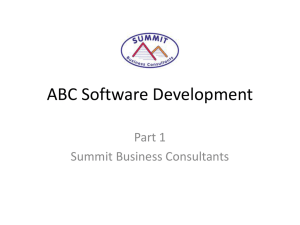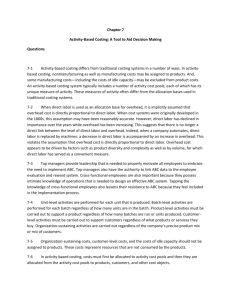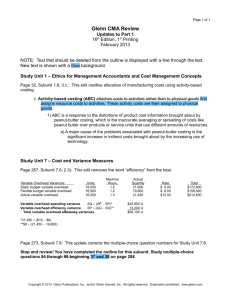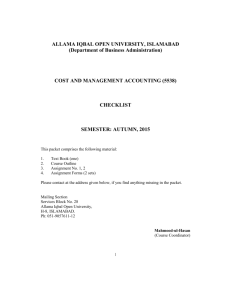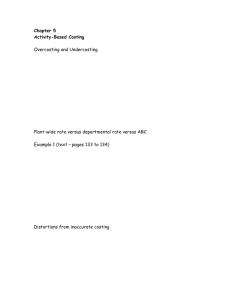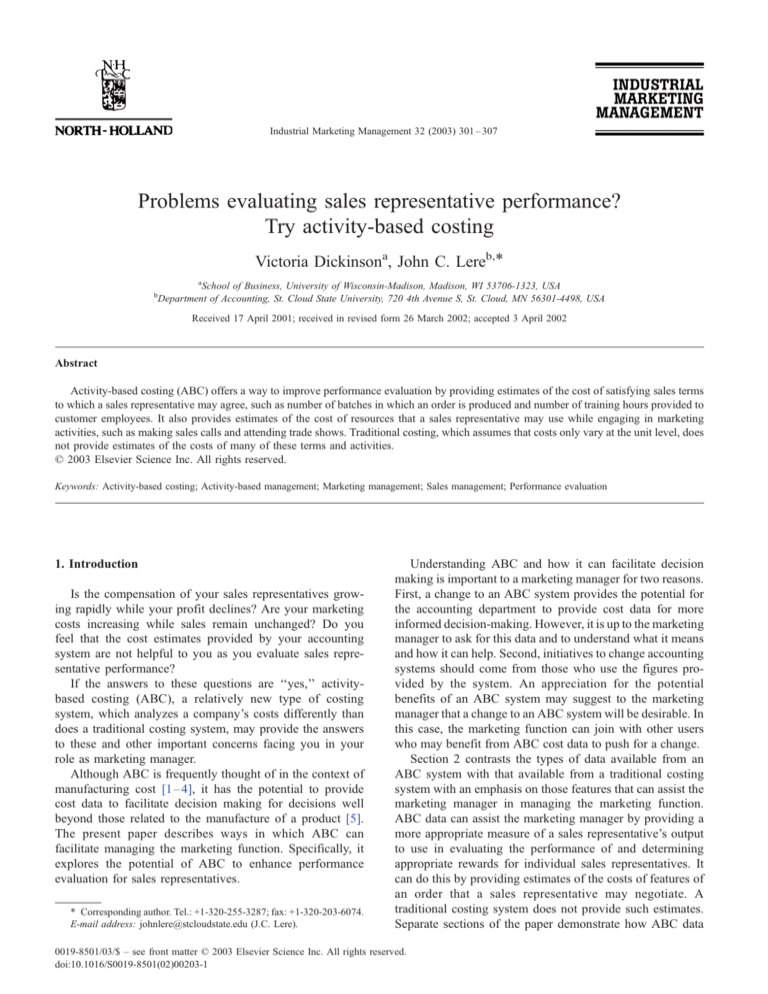
Industrial Marketing Management 32 (2003) 301 – 307
Problems evaluating sales representative performance?
Try activity-based costing
Victoria Dickinsona, John C. Lereb,*
a
b
School of Business, University of Wisconsin-Madison, Madison, WI 53706-1323, USA
Department of Accounting, St. Cloud State University, 720 4th Avenue S, St. Cloud, MN 56301-4498, USA
Received 17 April 2001; received in revised form 26 March 2002; accepted 3 April 2002
Abstract
Activity-based costing (ABC) offers a way to improve performance evaluation by providing estimates of the cost of satisfying sales terms
to which a sales representative may agree, such as number of batches in which an order is produced and number of training hours provided to
customer employees. It also provides estimates of the cost of resources that a sales representative may use while engaging in marketing
activities, such as making sales calls and attending trade shows. Traditional costing, which assumes that costs only vary at the unit level, does
not provide estimates of the costs of many of these terms and activities.
D 2003 Elsevier Science Inc. All rights reserved.
Keywords: Activity-based costing; Activity-based management; Marketing management; Sales management; Performance evaluation
1. Introduction
Is the compensation of your sales representatives growing rapidly while your profit declines? Are your marketing
costs increasing while sales remain unchanged? Do you
feel that the cost estimates provided by your accounting
system are not helpful to you as you evaluate sales representative performance?
If the answers to these questions are ‘‘yes,’’ activitybased costing (ABC), a relatively new type of costing
system, which analyzes a company’s costs differently than
does a traditional costing system, may provide the answers
to these and other important concerns facing you in your
role as marketing manager.
Although ABC is frequently thought of in the context of
manufacturing cost [1– 4], it has the potential to provide
cost data to facilitate decision making for decisions well
beyond those related to the manufacture of a product [5].
The present paper describes ways in which ABC can
facilitate managing the marketing function. Specifically, it
explores the potential of ABC to enhance performance
evaluation for sales representatives.
* Corresponding author. Tel.: +1-320-255-3287; fax: +1-320-203-6074.
E-mail address: johnlere@stcloudstate.edu (J.C. Lere).
Understanding ABC and how it can facilitate decision
making is important to a marketing manager for two reasons.
First, a change to an ABC system provides the potential for
the accounting department to provide cost data for more
informed decision-making. However, it is up to the marketing
manager to ask for this data and to understand what it means
and how it can help. Second, initiatives to change accounting
systems should come from those who use the figures provided by the system. An appreciation for the potential
benefits of an ABC system may suggest to the marketing
manager that a change to an ABC system will be desirable. In
this case, the marketing function can join with other users
who may benefit from ABC cost data to push for a change.
Section 2 contrasts the types of data available from an
ABC system with that available from a traditional costing
system with an emphasis on those features that can assist the
marketing manager in managing the marketing function.
ABC data can assist the marketing manager by providing a
more appropriate measure of a sales representative’s output
to use in evaluating the performance of and determining
appropriate rewards for individual sales representatives. It
can do this by providing estimates of the costs of features of
an order that a sales representative may negotiate. A
traditional costing system does not provide such estimates.
Separate sections of the paper demonstrate how ABC data
0019-8501/03/$ – see front matter D 2003 Elsevier Science Inc. All rights reserved.
doi:10.1016/S0019-8501(02)00203-1
302
V. Dickinson, J.C. Lere / Industrial Marketing Management 32 (2003) 301–307
reflect (1) the impact of terms negotiated by a sales
representative and (2) resources used by sales representatives on firm cost and profitability. The concluding section
of the paper provides a summary.
2. ABC versus traditional costing
The important distinctions between ABC and traditional
costing can be divided into issues of cost behavior and
issues of cost assignment. This section briefly reviews these
distinctions using manufacturing cost examples. Later sections expand this discussion to customer service costs and
marketing costs.
When applied in manufacturing, differences between
ABC and traditional costing are related to the handling of
manufacturing overhead (all production-related costs that
are not direct materials or direct labor).
Traditional costing divides costs into those that vary with
some measure of volume, ‘‘variable costs,’’ and those that
do not vary, ‘‘fixed costs.’’ For manufacturing overhead, the
volume measure used is units produced or one that varies
with units produced, such as direct labor hours (DLHs)
worked or machine hours worked.
GMI, a hypothetical firm that manufactures products to
customer specifications, provides an illustration. A portion
of GMI’s manufacturing overhead increases at the rate of
US$4.65/DLH. Therefore, GMI’s variable manufacturing
overhead is US$4.65/DLH. Most of the costs that make up
GMI’s manufacturing overhead, such as the depreciation
cost on the manufacturing facility, the cost of retooling a
machine for a new production run, and the cost of redesigning a product, do not vary with volume. At GMI, the total of
these fixed manufacturing overhead costs is US$11,610,000.
Unlike traditional costing, ABC recognizes that some
costs that do not vary with a volume measure such as DLHs
do vary with other measures. In ABC, the activities that
cause a cost to be incurred or the measures with which a
cost varies are called cost drivers. ABC categorizes drivers
by unit-, batch-, and product-level activities. Unit-level
activities are those activities that are performed on every
unit of product. Examples of unit-level manufacturing
activities are machining products, assembling products,
and inspecting products. Batch-level activities are performed on a group of units and usually include activities
such as machine set-up and material handling. Product-level
activities are tasks that relate to a specific product in its
entirety and can include design re-engineering, product
design testing, and parts administration.
As in traditional costing, there are some costs that do not
vary with unit-, batch-, or product-level cost drivers. These
costs are called facility-level costs. They include costs such
as depreciation on equipment and property taxes on facilities, as well as costs associated with such activities as
factory security, custodial maintenance, and grounds maintenance [6].
Table 1
Unit-, batch-, and product-level activities at GMI
Activity
Level
Cost driver
Rate
Power usage
Unit
US$1.10/MH
Inspection
Machine setup
Materials
handling
Parts
administration
Product
engineering
Unit
Batch
Batch
Machine
hours (MH)
Units
Number of setups
Moves
Product
Product
Number of
new parts
Engineering
hours (EH)
US$2.10/unit
US$750.00/setup
US$210.00/move
US$1000.00/new part
US$31.00/EH
GMI identified seven activities: power usage, inspection,
machine setup, materials handling, parts administration,
product engineering, and providing space. The cost driver
and cost per unit of cost driver for each unit-, batch-, and
product-level activity are shown in Table 1. The cost per
unit of cost driver for each of these activities represents the
increase in total manufacturing cost GMI expects for each
unit increase in the activity’s cost driver.
Providing space is a facility-level activity. An analysis by
GMI’s accountants indicates that the total cost of providing
space is US$6,930,000. This cost behaves like the traditional costing fixed cost.
Assigning fixed manufacturing overhead and the cost of
facility-level activities to units creates a challenge because
these costs do not vary at the unit level. Therefore, these
costs are allocated to units.1
Because their variable manufacturing overhead varies
with DLHs, GMI allocates fixed manufacturing overhead
to units using a rate based on DLHs. GMI anticipates that
600,000 DLHs will be worked during the year. This yields a
fixed manufacturing overhead rate of US$19.35/DLH
(US$11,610,000/600,000 DLH). When combined with
GMI’s variable manufacturing overhead rate of US$4.65,
this yields a total manufacturing overhead rate of US$24/
DLH. The top portion of Table 2 illustrates the computation
of the cost for Job #IM939 using this overhead rate.
The bottom part of Table 2 illustrates computation of the
cost of Job #IM939 if GMI uses ABC. The direct material
and direct labor costs of the job are the same as when a
single overhead rate based on DLHs is used. The difference
is in the assignment of overhead. Now the cost of each unit-,
batch-, and product-level activity is assigned to the job
based on the job’s use of that activity.
At GMI, the cost of the facility-level activity is allocated
using a rate based on units. Because GMI plans to produce
700,000 units, their allocation rate for providing space is
US$9.90/unit (US$6,930,000/700,000 units).
As indicated in Table 2, the traditional costing system
results in a higher cost assignment of US$7094 (US$55,500–
1
For a more detailed discussion of overhead cost assignment issues,
see Ref. [2].


